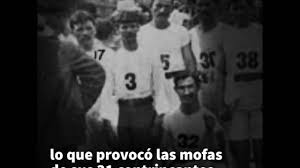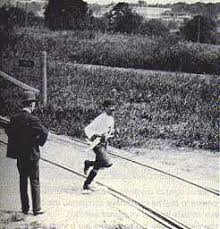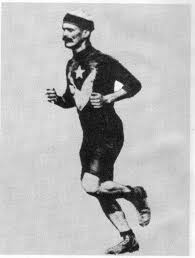 FRASE POPULAR CUBANA: “CAMINÓ MAS QUE EL ANDARÍN CARVAJAL..”. HISTORIA.
FRASE POPULAR CUBANA: “CAMINÓ MAS QUE EL ANDARÍN CARVAJAL..”. HISTORIA.
Felix Carvajal Soto, “el andarín Carvajal”, como todos le decian, nació en Águila esquina a San Lázaro, en La Habana, en 1867. Carvajal, de niño se estableció con sus padres en San Antonio de los Baños.
Félix amaba sincera y desinteresadamente el deporte y pese a carecer de orientación en sus entrenamientos, tenía condiciones excepcionales para las carreras de fondo. De haber nacido en otra época tal vez hubiera sido mucha la gloria que habría dado a Cuba.
Pero a Carvajal le tocó vivir lo mejor de su existencia durante las décadas iniciales de la República. Los Gobiernos de entonces no lo ayudaron y poco consiguió de la iniciativa privada.
Fue en esa localidad (San Antonio de los Baños) donde se anotó su primera victoria como corredor al derrotar al maratonista español Mariano Bierza, que iba de pueblo en pueblo jactándose de su resistencia.
A las siete de una mañana del domingo comenzaron a dar vueltas alrededor del parque repleto de vecinos y curiosos. A las cinco de la tarde, Bierza abandonó la prueba; Carvajal corrió hasta las siete de la noche.
El andarín Carvajal está en el imaginario de los habaneros, que suelen recordarlo, sobre todo los más viejos, con una frase: ‘Caminó (o caminé) más que el andarín Carvajal’. Incluso, ya anciano recorría kilómetros y kilómetros sin dar muestras apenas de cansancio.
Olimpiadas de San Luis
Cuando se acercaban las Olimpiadas de 1904, en San Luis, EE. UU., pidió ayuda al Gobierno del presidente Estrada Palma para que le costease el viaje y poder representar a Cuba en las competencias. Nada obtuvo y aun así el andarín Carvajal se las arregló para arribar a la cita olímpica. Hizo exhibiciones y colectas y embarcó con destino a Nueva Orleans para desde allí proseguir hasta San Luis.
Pensaba hacer ese trayecto en tren, pero —aseguran algunos autores— perdió el dinero del pasaje en prostíbulos y juegos de dados. No se dio por vencido. Emprendió a pie los 1200 kilómetros que lo separaban de la ciudad olímpica. Fueron unos diez días sin descanso y sin más comida que la que le ofrecían familias generosas y las frutas que podía coger en el camino.
Llega minutos antes de que se iniciara la carrera de maratón y logra inscribirse en representación de los colores del patio. Encuentra otro inconveniente: no tiene ropa apropiada para la carrera.
Un atleta norteamericano acude en su ayuda y con una tijera corta las patas del pantalón del cubano para convertirlo en una especie de short y al cortar las mangas deja su camisa convertida en una suerte de camiseta. Solo sus pesados zapatones no hallaron sustitución.
Ninguno de los componentes de la mesa de inscripción arrienda ganancia a aquel aspirante flacucho y de apenas 1,52 metros de estatura que de seguro, afirman, no llegará a la mitad de la competencia. Veintisiete de los 38 atletas inscritos ocupan sus puestos tras la línea de salida.
El trayecto escogido es complejo y difícil; incluye no pocas elevaciones y tramos sin pavimentar en que debe avanzarse sobre la roca viva, dificultades a las que se suma el calor, la falta de agua y el polvo que levantan los autos en que viajan jueces y periodistas.
Encabeza el cubano la justa durante los diez kilómetros iniciales y sigue al frente de la competencia en los diez kilómetros siguientes. Pero el hambre acalambra su estómago cada vez con más fuerza. Lo tientan los manzanos que crecen a los lados del camino.
No resiste la tentación y se detiene a comer sin importarle que las manzanas estén verdes. Come hasta saciarse y vuelve a la carrera. Las manzanas verdes, el estómago estragado y el hambre vieja le pasan la cuenta. El dolor de estómago se le hace insoportable y los retortijones apenas le permiten dar un paso.
Sale Carvajal de la pista y se agacha detrás de un árbol. Cree que el malestar ha pasado y vuelve a la carrera. Pero debe salir de la pista una y otra vez. Cuatro de los contendientes le pasan por el lado, pero queda al fin en tercer lugar cuando los jueces retiran el primer premio al campeón norteamericano al comprobar que hizo en automóvil parte de la travesía.
Concluye la olimpiada y el andarín Carvajal decide permanecer en Norteamérica. Superada la amargura del fracaso, se mide en otros torneos y competencias. A su regreso a Cuba, 14 meses después, Rafael Santa Coloma lo fotografía para la revista El Fígaro.
El pie de foto da cuenta de las medallas de oro que ha obtenido en competencias celebradas en San Luis, Washington, Chicago y Missouri, en tanto que la instantánea lo capta junto al trofeo más importante que cosechó en la gira: la copa de oro y plata ganada en una de las competencias.
Últimos días del Andarín Carvajal.
Unos pocos dias antes de su muerte, ya enfermo y con los dolores propios de una hernia inguinal, circunvaló La Habana con el corredor argentino Guerrero. Terminaron en el estadio del Cerro —Latinoamericano—, donde dieron varias vueltas al terreno antes de que se iniciara el juego de pelota.
El público, puesto de pie, lo ovacionó durante largos minutos. Dijo: “Hice esto porque di mi palabra y nunca he faltado a ella y también para que todos vean que el andarín Carvajal corre todavía”.
Eran las siete de la tarde del 27 de enero de 1949. En la Casa de Socorros de Marianao, el médico de guardia, en verdad un estudiante de apellido Cabrera, escribió bajo el número 451 del Registro: ‘Félix Carvajal, blanco, cubano, de 82 años de edad… Al examen médico presenta los síntomas reales de la muerte…’.
Feliz Carvajal de haber nacido en otra época tal vez hubiera sido mucha la gloria que habría dado a Cuba.
 CUBAN POPULAR PHRASE: “RUNNED MORE THAN THE ANDARIN CARVAJAL..”. HISTORY.
CUBAN POPULAR PHRASE: “RUNNED MORE THAN THE ANDARIN CARVAJAL..”. HISTORY.
Felix Carvajal Soto, the walking Carvajal, as everyone told him, was born in Águila on the corner of San Lázaro, in Havana, in 1867. Carvajal, as a child, settled down with his parents in San Antonio de los Baños. It was in that town where he scored his first victory as a runner when he defeated the Spanish marathon runner Mariano Bierza, who went from town to town boasting about his resistance.
At seven o’clock on a Sunday morning, they began to circle around the park full of neighbors and onlookers. At five o’clock in the afternoon, Bierza abandoned the test; Carvajal ran until seven at night.
The Carvajal walker is in the imagination of the Habaneros, who usually remember him, especially the older ones, with a phrase: ‘He walked (or walked) more than the Carvajal gait’. Even as an old man he traveled miles and miles without showing signs of weariness.
Felix Carvajal Soto sincerely and selflessly loved the sport and in spite of lacking orientation in his training, he had exceptional conditions for the races in the background. Had he been born in another era, perhaps the glory he would have given to Cuba would have been much.
But Carvajal had to live the best of its existence during the initial decades of the Republic. The governments of then did not help it and little got of the private initiative.
Olympics of San Luis
When the Olympics of 1904 approached, in San Luis, EE. UU., Asked for help from the Government of President Estrada Palma so that he could afford the trip and be able to represent Cuba in the competitions. Nothing was obtained and even so the Carvajal footman managed to arrive at the Olympic event. He made exhibitions and collections and boarded to New Orleans to proceed from there to San Luis.
He thought to make that trip by train, but some authors claim-lost the money from the passage in brothels and dice games. He did not give up. He undertook on foot the 1200 kilometers that separated him from the Olympic city. It was about ten days without rest and without more food than that offered generous families and fruits that could catch on the road.
He arrives minutes before the marathon race began and manages to register in representation of the colors of the playground. Find another drawback: he does not have appropriate clothes for the race.
An American athlete comes to his aid and with a pair of scissors cut the legs of the Cuban’s pants to turn it into a kind of shorts and when cutting the sleeves leaves his shirt turned into a sort of shirt. Only his heavy shoes did not find a substitution.
None of the components of the registration table rents profit to that skinny applicant and barely 1.52 meters tall who surely, they say, will not reach half of the competition. Twenty-seven of the 38 registered athletes take their places after the starting line.
The chosen route is complex and difficult; it includes not a few elevations and unpaved stretches in which it is necessary to advance on the living rock, difficulties to which the heat is added, the lack of water and the dust that the cars in which judges and journalists travel.
He heads the Cuban race for the first ten kilometers and continues to lead the competition in the next ten kilometers. But hunger cramps his stomach with increasing force. They are tempted by the apple trees that grow on the sides of the road.
It does not resist the temptation and stops to eat without caring that the apples are green. Eat until satisfied and return to the race. The green apples, the ravaged stomach, and the old hunger will count. The stomach ache is unbearable and the cramps just allow you to take a step.
Carvajal leaves the track and crouches behind a tree. He believes that the discomfort has passed and he returns to the race. But you must leave the track again and again. Four of the contenders pass him by the side, but he is finally in the third place when the judges retire the first prize to the North American champion when he checked that he made part of the trip by car.
The Olympiad concludes and the walker Carvajal decides to remain in North America. Overcome the bitterness of failure, is measured in other tournaments and competitions. Upon his return to Cuba, 14 months later, Rafael Santa Coloma photographed him for El Fígaro magazine.
The caption shows the gold medals obtained in competitions held in San Luis, Washington, Chicago, and Missouri, while the snapshot captures it along with the most important trophy that he won on the tour: the gold cup and silver won in one of the competitions.
Last days of the Andarin Carvajal.
It was seven o’clock in the afternoon of January 27, 1949. At the Casa de Socorros de Marianao, the doctor on duty, in truth a student named Cabrera, wrote under number 451 of the Registry: ‘Félix Carvajal, white, Cuban, 82 years old … At the medical examination presents the real symptoms of death … ‘.
Days before, already ill and with the pains of an inguinal hernia, he circumvented Havana with the Argentine runner Guerrero. They finished in the stadium of Cerro -Latinoamericano-, where they gave several turns to the ground before the ballgame began.
The public, standing up, cheered him for long minutes. He said: “I did this because I gave my word and I never missed her and also for everyone to see that Carvajal is still running.”
If Carvajal would had he been born in another era, perhaps the glory he would have given to Cuba would have been much.
Agencies/ RHC/ Ciro Bianchi/ Martha Rios/ Extractos/ Excerpts/ Internet Photos/ Arnoldo Varona/ www.TheCubanHistory.com
THE CUBAN HISTORY, HOLLYWOOD.



 < CUBAN Popular Phrase: "Runned More than The Andarín Carvajal".. History.
< CUBAN Popular Phrase: "Runned More than The Andarín Carvajal".. History.







